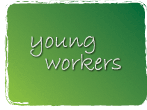Parents and Educators Can Keep Young Workers Safe
As parents and educators, you play an important role. Here is vital information you need to know.
- Employers must provide a safe and healthful workplace and comply with OSHA standards to prevent injuries and illnesses. Employers must train new workers on job hazards and safe work practices in a language they understand. Employers must also pay for most types of required safety gear.
- Child labor laws restrict the types of jobs and the hours that youth under age 18 can work. They also prohibit workers under age 18 from using certain equipment. Learn about the federal and state child labor laws that apply to young workers.
- States may develop and operate their own job safety and health programs with federal OSHA's approval and monitoring. There are currently 22 states and jurisdictions operating complete state plans (covering both the private sector and state and local government employees) and five plans that cover public employees only. To learn if your state has its own job safety and health program, see State Occupational Safety and Health Plans.
Parents
Take an active role in the employment decisions of your children:
- Be aware. Know where your children are working and what they are doing.
- Ask questions. Frequently ask about what they did at work and the training and supervision provided by the employer. Discuss any problems or concerns.
- Report hazards. Help your young worker report hazards to managers or, if necessary, to OSHA if a work environment seems unsafe.
- Watch for signs of concern. Is a job taking too much of a physical or mental toll on your young worker? How is your child’s performance at school? A loss of interest in or energy for school could mean the job is too demanding. Other signs of concern could include increased stress levels, anxiety, fatigue and depression.
Educators
As an educator, you can help protect young workers in several ways:
- Understand your role. You have an important opportunity to teach students safety and health skills to help them succeed and be safe at work. Help young workers build safety consciousness from their first job forward.
- Teach young workers their rights and provide safety information. Incorporate information about workers’ rights and occupational safety and health hazards into the high school and middle school curriculum. Integrate health and safety training into your general education and vocational programs. Students can use this knowledge throughout their careers, and it may be the only training they get before joining the workforce.
Here are some resources for educators:
- The National Institute for Occupational Safety and Health (NIOSH) Youth@Work: Talking Safety curriculum can be used in the classroom or other group trainings. It has been customized for each state and Puerto Rico to address state-specific rules and regulations. It includes step-by-step instructions for presenting the material.
- The Work Safe Work Smart curriculum teaches occupational health and safety issues to high school students with the goal of reducing injury rates of young workers.
- The Resources section of this website contains additional workplace safety and health materials.
OSHA Is Here to Help!
The Occupational Safety and Health Administration (OSHA) is the agency of the Department of Labor (DOL) that protects workers from dangers on the job that can cause injuries or illnesses. OSHA is here to help you. Call us on our toll-free number: 1-800-321-OSHA (6742) or TTY 1-877-889-5627 to get answers to your questions, or to ask OSHA to inspect your workplace if you think there is a serious hazard. You can also submit a question online. To file a confidential complaint about workplace hazards, visit our How to File a Complaint page for instructions.

 Newsletter
Newsletter RSS Feeds
RSS Feeds Print This Page
Print This Page
 Text Size
Text Size









